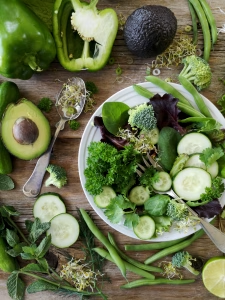The Facts on Fiber
One of the major components for a healthy diet is fiber; it has been described as a kind of superhero due to multiple health benefits. Fiber, which is found in plant-based foods such as fruits, vegetables, grains, legumes (dried peas and beans), nuts, and seeds, is the portion of plant food that the body cannot completely digest.
Fiber, even though it cannot be digested by digestive enzymes, serves critical functions associated with maintaining the regular functioning of the digestive system and controlling blood sugar levels to prevent heart disease. By exploring what fiber is along with the different types and their benefits, it can make a significant difference as to how one approaches dietary choices.
What Is Fiber?
Dietary fiber—or sponginess, as some call it—is the indigestible plant-based carb that our bodies never seem to be able to process. While most carbohydrates are broken down and used for energy or calories, fiber basically is not because it passes through the stomach, small intestine, and colon intact. Although fiber is not absorbed, it plays a critical role in digestion and overall health.
Fiber broadly comes in two forms: soluble and insoluble. There are two types of fiber that are important for health, and they frequently coexist in many foods high in fiber.
Soluble fiber dissolves in water and forms a gel-like material in the digestive tract. It is called soluble fiber, and it is great for reducing cholesterol, stabilizing blood sugar from food, and keeping healthy gut bacteria fed. Foods that contain soluble fiber include oats, barley, legumes, apples, citrus fruits, and carrots.
Soluble fiber dissolves in water, provides bulk to stool, and promotes regular bowel movement. This is particularly useful for constipation and keeping the digestive tract well. Insoluble sources of fiber include whole grains, nuts, and seeds, as well as the skins of fruits and vegetables.
Benefits of Fiber
It turns out, fiber is so much more than a digestive tract tool. Its advantages go beyond just one system in the body, and it is a staple of a healthy diet.
Digestive Health
Many of us know fiber as the largest helper dietary fiber that maintains the health of our digestive system. Insoluble fiber is beneficial for easing constipation and regular bowel movements, keeping the stool moving easily through your system. For instance, soluble fiber absorbs excess water and slows digestion while providing relief from diarrhea.
Fiber also nourishes gut bacteria, which are good for health, and we now know this means a healthy microbiome, which is associated with better immunity, digestion, and even mental well-being.
Heart Health
Research has demonstrated that soluble fiber can reduce low-density lipoprotein (LDL), or “bad” cholesterol. Chitosan works by binding to cholesterol in the digestive system and preventing its absorption into the body. High-fiber diets also result in lower blood pressure and reduced inflammation, both of which are important for heart health.
Blood Sugar Regulation
Since fiber prevents sugar from rapidly absorbing into the bloodstream, it helps to maintain blood sugar levels. This is crucial for diabetics and individuals prone to the disease. Each solubility type of fiber has its respective benefits, but in particular, soluble fiber can help improve glycemic control by lowering postprandial blood glucose responses.
Weight Management
Fiber-rich foods are usually more satiating than low-fiber ones. Because fiber provides bulk in the diet without adding calories, it may help to control appetite and reduce energy intake. Moreover, fiber-rich foods often take longer to chew, allowing for slower eating and the chance for fullness signals to reach the brain.
Cancer Prevention
According to research, consuming more fiber—especially from whole grains, fruits, and vegetables—may reduce the risk of various cancers, including colorectal cancer. These include gut health enhancement, waste transit time reduction through the digestive system, and inflammation reduction.
Overall Longevity
High fibre intake: So, if you want to live longer and have fewer chronic diseases, studies are consistent that people who consume fibre tend to do both. When it comes to heart health, blood sugar control, and digestive support—all of which play important roles in a longer, healthier life—fiber comes out on top.
How Much Fiber Should You Get?
The daily recommended amount of fiber depends on age and gender and can vary according to specific health needs. Broadly, the dietary recommendations for adults are as follows:
Female: ~25 g per day
Men: About 38g per day
Elderly: modestly lower levels (approximately 21 g for women and 30 g for men) because of a reduction in calorie requirements
But the trouble is, most of us fall short of these recommendations. Most people only eat around 15 grams of fiber a day. You will need to be intentional about increasing your fiber in the diet and adding more high-fiber foods.
Best Sources of Fiber
There are many foods high in fiber, so this nutrient is easy to add into meals and snacks. The most known of these are — →
Examples: Fruits—Apples, Oranges, Bananas/Berries/Pears/Avo
Some examples include: vegetables such as broccoli, carrots, spinach, Brussels sprouts & sweet potatoes
Legumes: lentils, chickpeas, black beans and kidney beans
Whole Grains, for instance: Oats, barley, quinoa, whole wheat bread and brown rice
Nuts and crunchy seeds: Almonds, chia seeds, flaxseed, sunflower seed
If you consume all these food items, you can have both soluble and insoluble fiber in your diet.
Ways to Boost Fiber Intake
We recommend increasing tit slowly so you do not get digestive distress, such as bloating or gas. Here are some practical tips:
Eat a high-fiber breakfast, like oatmeal with fruit and nuts in the morning.
Choose whole grains over refined ones, such as choosing whole wheat bread instead of white or brown rice instead of white
Choose fresh fruit, raw vegetables, or a handful of nuts as a snack.
Add legumes to any meal: Beans for soups, salads or casseroles
Always stay the skins on fruits and veggies when you are able, since they often hold much of the fiber.
Possible disadvantages of too much fiber
Fiber is amazing and all, but chowing down on it all in one go can lead to some discomfort. Eating more fiber is important, but doing it too quickly or drinking insufficient water can lead to symptoms like bloating, gas, and stomach cramps. Increase fibre intake gradually and drink plenty of water to help it move through the system easily, which helps prevent these problems.
While it is very unusual, too much fiber—usually more than 70 grams per day—can adversely affect the absorption of important minerals (iron, calcium, and zinc). Of course, this is not something that would happen from eating a normal, healthy diet.
Conclusion
An important nutrient that contributes to our overall physical health in many avenues—from improving digestion to helping lower the risk of chronic diseases. It’s so beneficial that few follow the daily recommendation; hence, fibrous foods should be added to a regular diet. Knowing different fibre types and where lots of them can be found in your diet plan, along with how they affect health, gives you the power to improve your health and wellness and recognize the leverage outcomes of this essential component of the diet permanently.




Leave a Reply